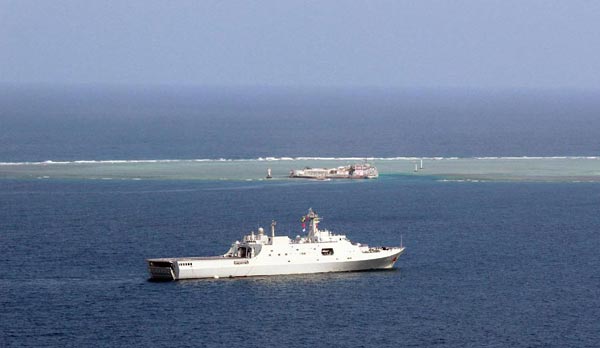US militarizing South China Sea
Updated: 2016-04-07 07:46
(China Daily)
|
||||||||
 |
|
A formation of the Nanhai Fleet of China's Navy on Saturday finished a three-day patrol of the Nansha islands in the South China Sea. [Photo/Xinhua] |
Despite being of a scale similar to last year's, the ongoing "shoulder-to-shoulder" military exercises between the United States and the Philippines are more provocative because of the addition of an islands-seizing exercise.
Such military exercises are one of the ways in which the US is militarizing the South China Sea. The military drills organized by the US unilaterally or together with its allies in the South China Sea in recent years have increasingly presented a provocative posture because of their shortened distance to sensitive areas in the sea. The exercise in which Philippine troops recapture islands occupied by "foreign troops" also makes the joint drill more targeted.
The US has frequently sent warplanes and warships on patrol in the South China Sea as part of its attempts to militarize the waters. Under the excuse of "freedom of navigation", in October, the guided-missile destroyer USS Lassen made a muscle-flexing sail through the 12-nautical-mile waters around a Chinese isle where reconstruction work was being completed, one of more than 700 patrols the US navy has made in the South China Sea over the past year. Washington has also strengthened its military deployment in the area, such as by signing a series of pacts with the Philippines to allow its vessels to use Philippine ports.
The South China Sea issue can be traced back to territorial disputes and rows over maritime rights following the illegal occupation of some islands and reefs of China's Nansha Islands by some countries, such as the Philippines, since the 1970s. It is China's consistent stance that disputes should be resolved directly with the parties concerned, based on historical facts and in line with international law. China is also committed to working with Southeast Asian nations to maintain peace, stability and freedom of navigation in the waters.
Militarization of the South China Sea benefits no one. The US should keep its promise of not taking sides, instead of fueling dissension and tension in the region.
- More cities take bonus and penalty in air pollution
- Shanghai police release list of 36 drivers banned for Life
- Police relax rules impeding delivery drivers
- Official's photos an unusual attraction in Chinese village
- 438 Chinese police officers die on duty in 2015
- Chinese 'parachute kids' flock to US schools
- Xi: Talks 'only correct way' for China, ROK
- Xi to Obama: Disputes should be managed
- Cypriot court remands in custody man suspected of hijacking EgyptAir flight
- Govt eyes luxury tourists amid concerns over safety
- Sleep tight and don't let sharks bite at Paris aquarium
- Aung San Suu Kyi appointed as Myanmar's new foreign minister

 Top Chinese leaders attend voluntary tree-planting in Beijing
Top Chinese leaders attend voluntary tree-planting in Beijing
 Zhouzhuang water town viewed through artistic eyes
Zhouzhuang water town viewed through artistic eyes
 8 trends of major price movements gauging China's economy
8 trends of major price movements gauging China's economy
 Migrant workers back home with their family
Migrant workers back home with their family
 Microsoft embraces artificial intelligence
Microsoft embraces artificial intelligence
 Yao Ming introduced to Hall of Fame
Yao Ming introduced to Hall of Fame
 The world in photos: March 28 - April 3
The world in photos: March 28 - April 3
 Discover beautiful China in spring blossom (V)
Discover beautiful China in spring blossom (V)
Most Viewed
Editor's Picks

|

|

|

|

|

|
Today's Top News
Marriott unlikely to top Anbang offer for Starwood: Observers
Chinese biopharma debuts on Nasdaq
What ends Jeb Bush's White House hopes
Investigation for Nicolas's campaign
Will US-ASEAN meeting be good for region?
Accentuate the positive in Sino-US relations
Dangerous games on peninsula will have no winner
National Art Museum showing 400 puppets in new exhibition
US Weekly

|

|







